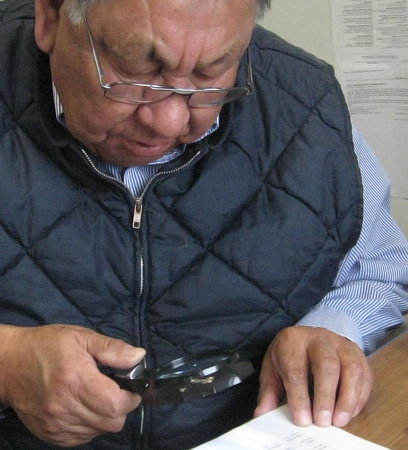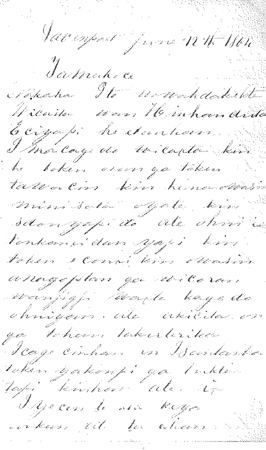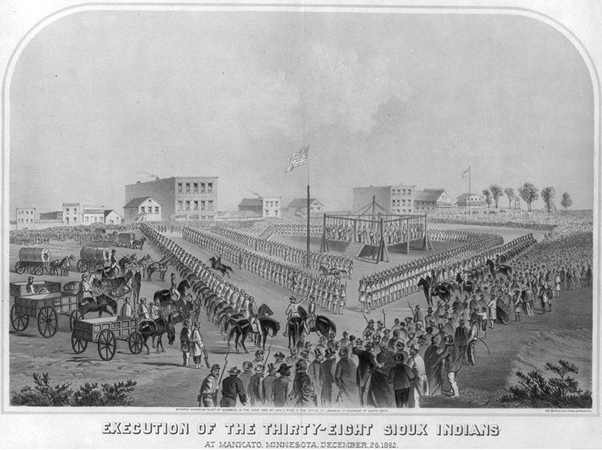A friend has sent me this link:
minnesota.publicradio.org/display/web/2011/01/19/dakota-tribe-letters/150-year-old letters give voice to Dakota prisonersby Dan Gunderson, Minnesota Public Radio
January 19, 2011

Clifford Canku teaches Dakota language at North Dakota State University in Fargo. He has spent the past 10 years, working with other Dakota elders, translating 50 letters written by Dakota prisoners of war in the 1860s. (MPR Photo/Dan Gunderson)
Fargo, N.D. — For nearly 150 years, the voices of Dakota men imprisoned after the Dakota Conflict of 1862 went unheard.
But the details of their imprisonment are starting to emerge, in letters written by those prisoners after six weeks of fighting along the Minnesota River Valley that left hundreds of Indians, settlers and soldiers dead.
In a tiny office at North Dakota State University in Fargo, Clifford Canku has spent 10 years poring over the faint handwriting with a magnifying glass.
"One letter would take about a week," said Canku, a Dakota elder who teaches Dakota language at North Dakota State. Canku is one of three lead translators on the project, which has unearthed never-before revealed details of a turbulent episode in Minnesota history.
Some of the letter writers talk about the war; others describe prison life.
"We're very cold, and they took the stove away from us," one prisoner wrote. "It's way below zero and we're freezing. A lot of people have died."
The letters add important first-person perspective to a troubling time in history, said professor Bruce Maylath, one of Canku's colleagues in the NDSU English Department. They plan to publish 50 of the letters.
"There's a lot to be bothered by," Maylath said. "This has been a one-sided story to this point. And for the first time this tells the other side -- directly from the Dakota side. And it tells it in the language they were most comfortable in."
The written Dakota language was created by a Presbyterian missionary, Stephen Riggs. When the prisoners wrote to him, he would share the letters with families. The letters, along with other documents, were stored in a box at the Minnesota Historical Society for decades.
Hundreds of Dakota men were imprisoned after the war. Some 300 were sentenced to death. President Abraham Lincoln commuted the death sentence of 265 men, who were then sent to the prison at Fort McClellan in Davenport, Iowa.
Maylath said the letters indicate prisoners were under great pressure to convert to Christianity. Interestingly, while missionaries were trying to save their souls, the Dakota understood being "saved" to mean they would not be hanged. Maylath said the letter writers asked about young men who disappeared from prison.
"There's speculation in the letters about perhaps the young men disappeared because they refused to convert to Christianity," he said. "We do know those young men were never seen again."
Descendants of the letter writers are alive today. Some of the translators recognized names while reading the letters for the first time at the Minnesota Historical Society.
"One of them would turn to me with a letter and say, 'Flag this one. It's by my great-great-grandfather.'" Maylath said. "And to have the voices of the ancestors right there, visible in their own handwriting, that was the most moving thing to me."
The letters reflect the Dakota prisoners' concern after Lincoln was assassinated. The men feared they might be killed now that the man who saved them was dead.
Canku said some letters are painful to read. He said the prisoners' letters tell how at night, guards would rape the Dakota women who worked at the prison camp, cleaning and cooking.
"When they [guards] came after the women at night, they didn't have any recourse but to sing and let them know, and pray," Canku said, "to let the women know 'we're leaving you in the presence of God. Because if we were able to help we would have stopped what's going on. But we can't.'
"When we read these letters to common everyday people, especially the women cry and go through a tremendous amount of anguish, because they have their own stories about what happened to their relatives back then," Canku said. "A lot of them were killed. Women were raped."
Canku said the content of some letters is likely to be controversial. Some letters are likely to upset Dakota people, since they identify Dakota men who collaborated with the U.S. Army. Their descendants don't want that information publicized, he said.
The letters also raise uncomfortable questions for historians.
"What happened? Did they have concentration camps in Minnesota? Even today, people don't believe that," Canku said. "People died. They were in prison. They experienced genocide. And when you talk about these things you are going to get opposition saying, no, these things didn't happen. But they did happen."
For Canku, the project is about truth telling. He said it's time for these long silent voices to be heard.
"I think it's spiritually inspired by our ancestors," he said. "It's time to do this and give the information out. I feel a tremendous responsibility to carry this through."
The 50 letters translated so far were chosen because they represent a cross-section of the 150 letters in the collection.
The letters will be published early next year in book form with the original Dakota language, the literal translation, and the contemporary English explanation.

A letter written in Dakota on June 12, 1864, from prisoner-of-war Anpetuwaste (Good Day) at the Fort McClellan prison camp near Davenport, Iowa, to Tamakoce (His Country, aka The Rev. Stephen R. Riggs) in St. Paul. Among other things, the letter describes the sadness that Anpetuwaste feels at having recently lost his son, who died while also being held at the prison camp. (Image courtesy Bruce Maylath)

Artist W. H. Childs' portrayal of the public execution of 38 Dakota Indians at Mankato in 1862. They were found guilty for their actions during the Dakota Conflict. (Library of Congress)